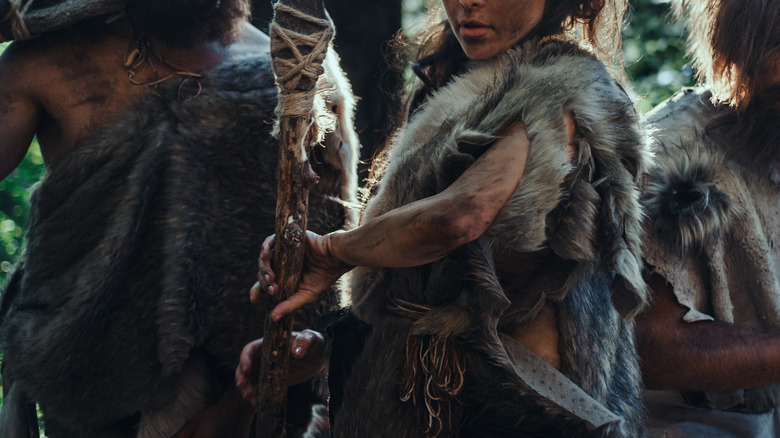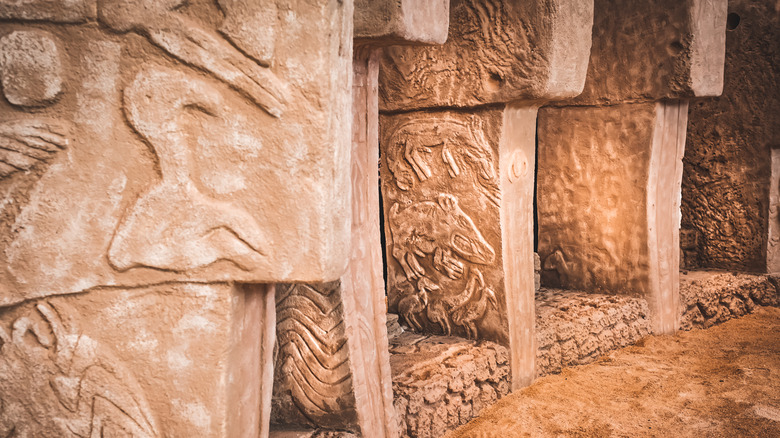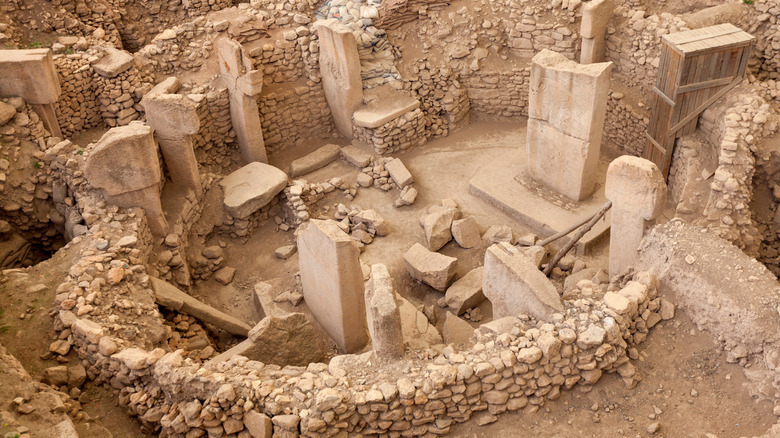The Unlikely Weapon Featured In The World's Oldest Narrative Carving
Here's a quick question for you: What do you figure is the world's oldest mythological story? Perhaps it's something that reflects mankind's hunter-forager roots, like a tale of hunting? As academic Jon White says on his YouTube channel Crecganford, the world's oldest, shared tale — about a hunter chasing sisters who transform into the seven stars of the Pleiades — might just date back to about 100,000 years ago. The "Lion Man," the world's oldest extant wood carving, features a humanoid with a lion's head and dates back to 40,000 years ago, per The Art Newspaper. And because wood is easier to shape than stone, the world's oldest stone carving dates back to 11,000 years ago. As Live Science explains, it features not only a similar animal-slash-hunting theme, but a hunter wielding an unlikely weapon: his own erect penis.
So yes, a phallus might not be the safest thing to wave around at wild beasts. Then again, maybe it was the best spear-like, phallic weapon he had available. Found in the Urfa region of southeastern Turkey — a stone's throw away from the world's oldest megalithic temple, Gobekli Tepe — the carving features a man standing in the middle of a swarm of leopards and bulls that look like they're converging on his position. And what does he do? Clutch his private bits. If this isn't a scene of combat, a protective gesture, or at least a display of defiant human virility, let's not think about the alternatives.
A story lost to time
Most importantly, the carving in question isn't simply a depiction of a boar, bird, bull, or some other object or animal from nature — it's a Neolithic comic strip, depicting a narrative scene from some long-lost tale. It speaks to us today in a top-down sense — people fighting animals — but there's absolutely no way to glean specifics. It might not actually be a singular, simple human vs. beasts story, but more of a general representation of human life, or even a type of tale.
Whether it's religious or not is unknown, but ancient folks didn't really harbor any divisions between the spiritual and the secular. We also don't know whether it's meant symbolically or literally. The carving has been informally dubbed the "Sayburç relief" after the name of the archaeological site where it was found in Turkey, about 20 miles (32 km) north of the Syrian border and 35 miles (56 km) east of the Euphrates River, per Live Science. The carving is a relief rather than a free-standing or detached work. This means it was etched into bedrock in such a way that its figures pop. Digging at the site began in 2021, and quickly revealed a "communal building" where the carvings appear on a limestone bench. The building itself is about 36 feet long (11 meters), and the carving is about 12 feet long (3.7 meters) by 3 feet tall (0.9 meters).
At the dawn of agriculture
The whole "human vs. beasts" thing might have more significance beyond ancient peoples simply complaining "those dang boars" or whatever. This is especially true given the time period to which the Sayburç relief dates, and its location. It goes back to nearly the exact time and place as Gobekli Tepe, the world's oldest megalithic temple, which is absolutely littered with animal imagery, as Smithsonian Magazine explains. Gobekli Tepe is so old that it predates Stonehenge by 6,000 years. It was built before people settled into fixed towns, right at the dawn of agriculture nearly and before animal husbandry. Doesn't it make sense that one of the major conflicts of the time was that of the attempt to establish civilization, a fight against the wild, so to speak? At the very least, archaeologist Eylem Özdoğan on Live Science calls it a "reflection of a collective memory that kept the values of its community alive."
There are a couple oddities about the Sayburç relief worth noting. There are actually two males in the five-figure scene. A phallus-gripping one is facing the viewer, and to the left of him there's another one gripping a snake and doing some kind of dance — he's facing left. There's a horned bull to the left of that guy, while leopards stand on either side of the phallic guy. Meanwhile, the digging at Sayburç continues, and might uncover further clues about the relief's meaning.


